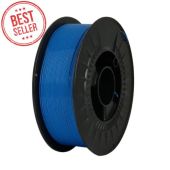Optimizing ABS Printing Temperature for Reliable 3D Prints
Introduction
ABS is one of the most widely used filaments in industrial FDM 3D printing due to its balance of toughness, heat resistance, and dimensional stability. However, its benefits are only fully realized when printed under tightly controlled thermal conditions. ABS is thermally sensitive, and even small deviations in temperature can result in warping, cracking, or poor inter-layer adhesion.
For professionals working in high-precision fields such as automotive prototyping, functional part manufacturing, or research, understanding the optimal temperature is essential. Improper temperature settings lead to wasted material, inconsistent performance, and longer iteration cycles.
Ideal Temperature Ranges for ABS Printing
The optimal nozzle temperature for ABS falls between 235°C and 245°C, though some printer/filament combinations may require slight adjustments. A heated bed is also required, generally in the range of 90°C to 110°C, to ensure proper adhesion and minimize warping during the first layers.
Beyond these figures, success with ABS also depends on managing environmental factors. Printing in an open-air setup often causes sudden temperature drops, which ABS does not tolerate well. A consistent chamber temperature and absence of airflow play a crucial role in stabilizing prints.
Environmental Control Is Key
ABS has a relatively high thermal contraction rate, making it especially prone to warping and delamination. When external temperatures fluctuate or cooling is uneven, the print contracts inconsistently, which causes cracks or lifted corners.
To counteract this, professionals use enclosed printers or create makeshift enclosures to keep ambient air stable. Some even add passive heaters or insulation to maintain steady internal conditions. In large parts or batch production, where mechanical stresses can accumulate layer by layer, a controlled chamber becomes a necessity.
Common Temperature-Related Issues and Solutions
Errors are usually linked to poor temperature control rather than hardware faults. Recognizing typical symptoms helps address them before they lead to failed prints or costly re-runs.
| Issue | Likely Cause | Solution |
|---|---|---|
| Under-extrusion | Nozzle temperature too low | Increase nozzle temp; check filament feed |
| Warping | Insufficient bed temperature or drafts | Raise bed temp; use enclosure |
| Cracking between layers | Fast cooling or inconsistent ambient temp | Use enclosure; slow cooling |
| Stringing and oozing | Excessively high nozzle temperature | Lower nozzle temp; optimize retraction |
While slicer adjustments and mechanical maintenance can improve some problems, consistent thermal control should be the first area of focus.
Advanced Considerations for Functional and Industrial Prints
ABS is often used in applications that involve stress, pressure, or outdoor exposure. In these contexts, poor print quality isn’t just cosmetic—it compromises performance. That’s why seasoned engineers not only control nozzle and bed temperatures but also monitor chamber air, dry the filament, and optimize retraction and fan settings.
Pro Tip: Dry ABS at 80°C for 4–6 hours before printing. Moisture causes bubbles, roughness, and internal voids. A dedicated filament dryer reduces print failures significantly.
Additionally, when printing large-format or load-bearing parts, slower print speeds—typically around 40 mm/s—help with consistent deposition and better layer bonding. Cooling fans should be turned off or set to a very low percentage to avoid sudden shrinkage.
Why Precision Matters in High-Temperature Materials
In sectors such as electronics or aerospace, dimensional accuracy and surface quality are non-negotiable. This raises the bar for process control. The temperature must be not only appropriate but also stable throughout the print.
Temperature swings of even 5–10°C during extrusion or on the print bed can introduce variable shrinkage, micro-cracks, or brittle layers. These defects may not be immediately visible but can lead to failure under mechanical or thermal stress.
3D printing professionals use thermal cameras, logging tools, and multi-point calibration systems to track and adjust printer behavior over time. For consistent part quality, they treat the printing environment with the same seriousness as the machine settings themselves.
3D Trček ABS Filaments: Designed for Professionals
With over five decades in plastics and more than ten years focused on filament development, 3D Trček has built a reputation for consistent quality and precision. Their ABS filaments are engineered for stable extrusion, minimal warping, and excellent layer adhesion, even on complex geometries.
Professionals across industries—including automotive, aerospace, and electronics—rely on Trček’s materials for small batch prototyping and functional part production. Each filament roll is manufactured to strict tolerances to ensure consistent diameter and composition, critical for thermal stability during extrusion.
The company’s range of over 20 materials and 150 colors supports diverse applications, while the filament's performance under high thermal loads makes it a reliable choice for repeatable, engineering-grade prints.
Final Thoughts
ABS remains a go-to material for professionals who need parts that hold up under stress, temperature, and time. But printing it successfully requires more than just compatible hardware. Achieving consistent output means understanding and controlling every thermal aspect of the process—from the hotend and bed to the ambient air and filament condition.
Use high-quality filament from 3D Trček, ensure your printer is enclosed, dry your filament before use, and keep your ABS printing temperature within the recommended range. These foundational steps can make the difference between repeatable success and frustrating inconsistency in your production workflow.
; ?>) Shop ABS Filament
Shop ABS Filament


Please complete your information below to login.
Sign In
Create New Account